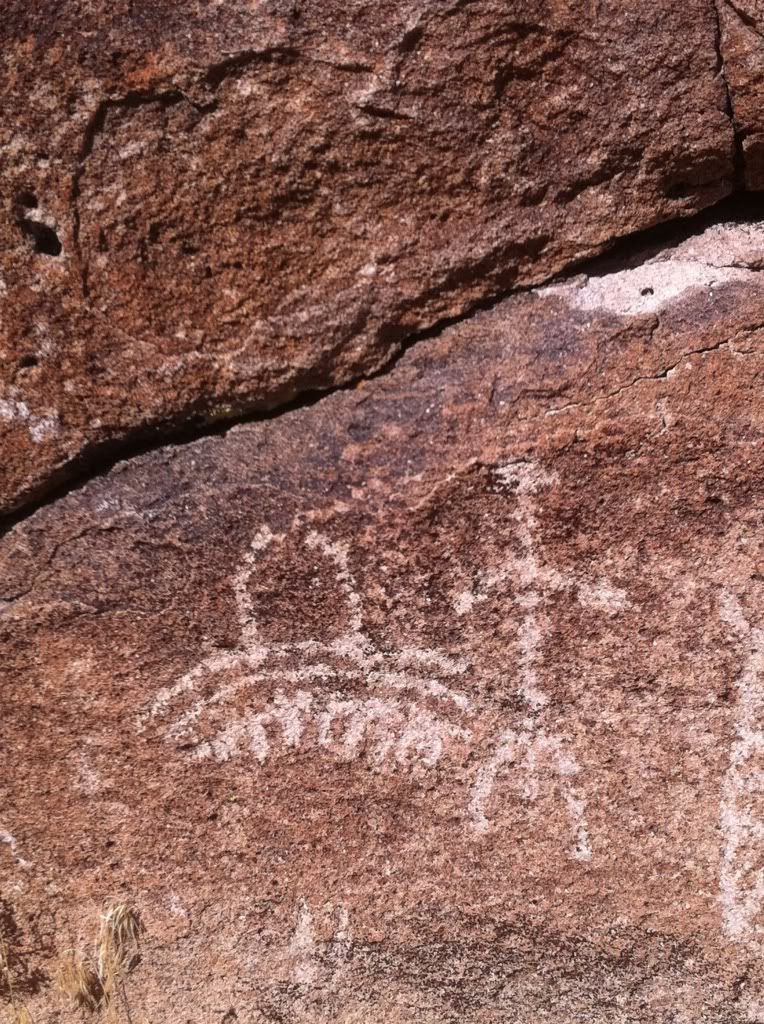Justin Gillis of the NY Times reported yesterday that global carbon emissions jumped 5.9 percent in 2010, the biggest increase ever recorded. This dashed any hopes that smaller increases during the Great Recession years were a sign humanity had somehow spontaneously and collectively adopted greener habits.
A couple quick facts from the report:
-- Coal consumption accounted for half the increase.
-- US emissions increased 4 percent, China 10.4 percent.
-- Developing countries accounted for 57 percent of the emissions, but emissions per person are much higher in developed nations.
Takeaway message: Don't count on economic trouble, or somebody else, to fix the climate change problem.
Tuesday, December 6, 2011
Sunday, December 4, 2011
Wednesday, November 2, 2011
Waste

I shot this the other day along the commuter rail tracks in Sacramento. It's a line of mercury vapor lamps, behind a strip of trendy eateries and bars on R Street, attempting to light up the day.
How often do you see stuff like this?
Sunday, October 30, 2011
Happy Halloween
Lots of press lately about the fact that Earth's human population is projected to reach 7 billion this week, as in this New Yorker piece by Elizabeth Kolbert. She notes that the projected day is tomorrow, Halloween. Yes, it's scary, so the timing seems appropriate.
More scary than the population number, however, is research mentioned by Kolbert that corn and soybean crop yields are projected to decline significantly by the end of this century. In other words, our food supply may not keep up with population growth, which is expected to continue rising: 8 billion in 2025, 10 billion in 2100, and still climbing.
I found the crop yield article, from Proceedings of the National Academy of Sciences in 2009. Kolbert picked the worst-case number from the study. But even under a less-bad climate change scenario, corn and soybean yields in the U.S. are projected to drop 30 percent.
I'm not going to fault Kolbert for picking the bigger number. Evidence is beginning to emerge that even the worst-case scenarios in the climate change models are starting to show signs that they are underestimating what's really going on (more on that at a future date).
The message -- however you slice the numbers -- is that we're about to drive the wheels off the family minivan. Somehow, we need to reconcile how we're growing as a species (population) and how we intend to feed that population.
More scary than the population number, however, is research mentioned by Kolbert that corn and soybean crop yields are projected to decline significantly by the end of this century. In other words, our food supply may not keep up with population growth, which is expected to continue rising: 8 billion in 2025, 10 billion in 2100, and still climbing.
I found the crop yield article, from Proceedings of the National Academy of Sciences in 2009. Kolbert picked the worst-case number from the study. But even under a less-bad climate change scenario, corn and soybean yields in the U.S. are projected to drop 30 percent.
I'm not going to fault Kolbert for picking the bigger number. Evidence is beginning to emerge that even the worst-case scenarios in the climate change models are starting to show signs that they are underestimating what's really going on (more on that at a future date).
The message -- however you slice the numbers -- is that we're about to drive the wheels off the family minivan. Somehow, we need to reconcile how we're growing as a species (population) and how we intend to feed that population.
Tuesday, October 18, 2011
New climate change rules for San Francisco Bay
The Bay Citizen reports that the San Francisco Bay Conservation and Development Commission on Oct. 6 adopted new rules that ban new shoreline development unless those projects can show benefits that outweigh the cost of protecting against sea level rise.
The commission initially planned to discourage all new shoreline development. But it got kickback from developers, and agreed to a compromise that may allow some projects to proceed if they demonstrate significant economic or environmental benefits.
It seems clear these rules have "national significance," as the commission's chairman stated. But it remains to be seen if they go far enough.
The Bay Area and its inland Sacramento-San Joaquin Delta are expected to see 55 inches of sea level rise -- that's 4.5 feet. It may well be that these early estimates are conservative. We may find out eventually that it makes more sense to retreat from the shoreline, rather than allow more development on it.
One looming proposal calls for 12,000 new homes on former salt flats in the South Bay.
The commission initially planned to discourage all new shoreline development. But it got kickback from developers, and agreed to a compromise that may allow some projects to proceed if they demonstrate significant economic or environmental benefits.
It seems clear these rules have "national significance," as the commission's chairman stated. But it remains to be seen if they go far enough.
The Bay Area and its inland Sacramento-San Joaquin Delta are expected to see 55 inches of sea level rise -- that's 4.5 feet. It may well be that these early estimates are conservative. We may find out eventually that it makes more sense to retreat from the shoreline, rather than allow more development on it.
One looming proposal calls for 12,000 new homes on former salt flats in the South Bay.
Sunday, October 16, 2011
Quote
"A lot of us are just biding our time, waiting to go back to the old ways. Can't be more than a few decades at the latest. We did okay out here without popcorn and weed whackers and Jet Skis."
-- Derrick Jensen, quoting a Hawaiian man, Orion Magazine, October 2011
-- Derrick Jensen, quoting a Hawaiian man, Orion Magazine, October 2011
Saturday, October 15, 2011
Rock art: Pondering the past, the future
Even the experts aren't really sure what to make of primitive rock art. Was it like road signs pointing to good hunting areas? A tribe's written history? Expressions of joy or reverence?
Probably all of the above. To me it's simply humbling and thought provoking.
I took these pictures at the Mt. Irish Petroglyph Site in Nevada. It's a remote site near Hiko where rock art by the Pahranagats, a clan of Paiute Indians, is quite numerous and impressive.
The Pahranagats lived in the area for 10,000 to 12,000 years. Some of the rock art may date back this far, but it is difficult to date accurately. But we can safely say that some of these petroglyphs are thousands of years old.
They were hunter-gatherers who followed big game and native plants. They were experts at survival and made the most of a challenging environment. At some point, they adopted a more settled existence, growing row crops and exploiting small, local game such as birds, insects and rodents.
They could not adapt to the arrival of European settlers in the 1860s, who pretty much exterminated the indians to get at the gold and silver veins underground.
That's why the rock art resonates. These are the Pahranagats' own pictures of what mattered in their lives, or reminders of important events.
Will our culture be around in 10,000 years? If not, what symbols will speak for us?
 |
| Bighorn sheep. Once abundant and vital to the Pahranagat, the species is now found in just a few remote pockets of Nevada. |
Probably all of the above. To me it's simply humbling and thought provoking.
I took these pictures at the Mt. Irish Petroglyph Site in Nevada. It's a remote site near Hiko where rock art by the Pahranagats, a clan of Paiute Indians, is quite numerous and impressive.
The Pahranagats lived in the area for 10,000 to 12,000 years. Some of the rock art may date back this far, but it is difficult to date accurately. But we can safely say that some of these petroglyphs are thousands of years old.
They were hunter-gatherers who followed big game and native plants. They were experts at survival and made the most of a challenging environment. At some point, they adopted a more settled existence, growing row crops and exploiting small, local game such as birds, insects and rodents.
 |
| Pahranagat tale of a UFO encounter? Some say it could be a sombrero. I think maybe a dwelling of some sort. |
That's why the rock art resonates. These are the Pahranagats' own pictures of what mattered in their lives, or reminders of important events.
Will our culture be around in 10,000 years? If not, what symbols will speak for us?
Thursday, October 6, 2011
Where we stand
Nearly two-thirds of Americans believe climate change is happening, according to this May 2011 Yale survey. They differ sharply about the cause, though the largest group, 47 percent, believes climate change is caused by human activity.
A more recent Reuters/Ipsos poll in September found that 83 percent of Americans believe climate change is occurring, an increase from 75 percent a year earlier.
Yet for various reasons - economic and political - we can't seem to do anything about it.
Any real solutions would require big changes in how we conduct business in this country, and likely some big changes in habit for all of us.
In the meantime, greenhouse gasses continue to accumulate, climate change accelerates, and we sit back while the weather becomes more unpredictable, natural disasters mount and a real fix gets farther out of reach.
What we can all do now is start adapting to climate change, both as individuals and as communities.
Governments at all levels give little attention to this need for adaptation. Are we building levees high enough, planning urban growth appropriately, setting aside emergency funds, thinking about future food supplies? Are your family, your property, your finances and your neighborhood ready?
Let's agree to disagree about the causes of climate change. For now. I'm here to talk about what we can all agree to do now, and that's begin to adapt.
Welcome to the Adaptivator.
A more recent Reuters/Ipsos poll in September found that 83 percent of Americans believe climate change is occurring, an increase from 75 percent a year earlier.
Yet for various reasons - economic and political - we can't seem to do anything about it.
Any real solutions would require big changes in how we conduct business in this country, and likely some big changes in habit for all of us.
In the meantime, greenhouse gasses continue to accumulate, climate change accelerates, and we sit back while the weather becomes more unpredictable, natural disasters mount and a real fix gets farther out of reach.
What we can all do now is start adapting to climate change, both as individuals and as communities.
Governments at all levels give little attention to this need for adaptation. Are we building levees high enough, planning urban growth appropriately, setting aside emergency funds, thinking about future food supplies? Are your family, your property, your finances and your neighborhood ready?
Let's agree to disagree about the causes of climate change. For now. I'm here to talk about what we can all agree to do now, and that's begin to adapt.
Welcome to the Adaptivator.
Subscribe to:
Posts (Atom)

